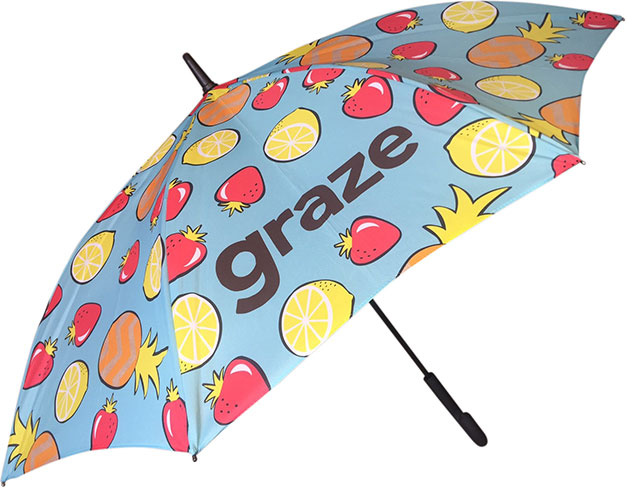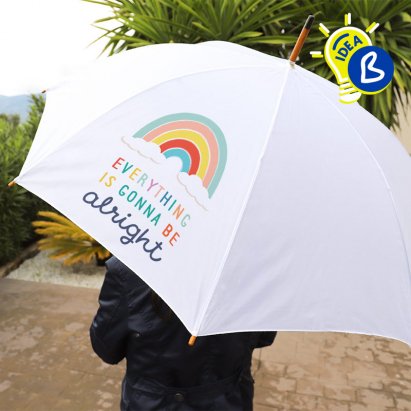An umbrella serves as both a practical accessory and a distinctive corporate gift, ensuring that each time the recipient uses it, they are reminded of your brand. To achieve a vibrant, multi-colored graphic or photographic print on an umbrella, sublimation printing is the ideal technique.
This process involves digitally imprinting the design onto fabric panels at our overseas facility before they are meticulously sewn together and assembled onto the frame. While sublimation printing offers striking, high-definition results, it comes with certain drawbacks—it is a relatively costly method, requires a higher minimum order quantity, and entails a longer production lead time. However, the outcome is an exquisite, attention-grabbing umbrella that leaves a lasting impression.

The Art of Sublimation Printing on Umbrellas: A Comprehensive Guide:Sublimation printing has revolutionized the customization industry, allowing intricate, full-color designs to be seamlessly transferred onto a variety of surfaces. Among these, umbrellas present a unique canvas for creative expression, offering both functionality and style. Whether for promotional branding, personalized gifts, or artistic endeavors, sublimation printing on umbrellas requires precision, the right materials, and a thorough understanding of the process. This guide will take you through every step, from selecting the right umbrella to achieving a flawless print.
Understanding Sublimation Printing
Sublimation is a heat-transfer process where solid dye transforms into a gas without passing through a liquid state, bonding permanently with polymer-coated or polyester-based materials. This method ensures vibrant, long-lasting prints that resist fading, peeling, or cracking. Unlike traditional printing techniques, sublimation infuses ink into the material rather than laying it on the surface, resulting in a smooth and durable finish.

Choosing the Right Umbrella for Sublimation
Not all umbrellas are suitable for sublimation printing. To achieve the best results, consider the following factors:
- Material Composition: Umbrellas made from 100% polyester or those with a polyester coating work best for sublimation. The ink binds effectively with polyester fibers, producing rich, detailed prints.
- Color: Light-colored or white umbrellas yield the most accurate and vibrant colors. Sublimation does not print white ink, so designs on darker backgrounds may lose clarity.
- Panel Structure: Look for umbrellas with fewer seams and smooth, wide panels to ensure an even print surface. Seamless panels help prevent distortion and ink dispersion issues.
Essential Tools and Materials
Before starting the printing process, gather the following equipment and supplies:
- Sublimation Printer: A high-quality printer with sublimation-specific inks is essential for precise and vibrant transfers.
- Sublimation Ink and Paper: Specially formulated sublimation ink and heat-resistant sublimation paper are necessary for successful transfers.
- Heat Press Machine: A press with an adjustable temperature setting ensures even heat distribution, crucial for effective sublimation. A curved or specialty press may be needed for certain umbrella designs.
- Protective Sheets: Heat-resistant Teflon sheets or parchment paper help prevent ink from transferring onto unwanted areas.
- Heat-Resistant Tape: Securely holds the sublimation print in place to avoid shifting during the pressing process.
Step-by-Step Sublimation Printing Process
1. Preparing the Design
Create or select a high-resolution design using graphic design software such as Adobe Photoshop, Illustrator, or CorelDRAW. Ensure the image dimensions match the umbrella panel size for a seamless fit. Remember to mirror the design before printing, as sublimation transfers in reverse.
2. Printing the Design on Sublimation Paper
Load the sublimation paper into your printer, ensuring the coated side faces up. Print using the highest quality settings to achieve vibrant colors and crisp details. Allow the print to dry completely before handling.
3. Positioning the Design on the Umbrella
Carefully align the printed design onto the desired umbrella panel. Secure it in place with heat-resistant tape to prevent any movement that could cause blurring or misalignment.
4. Applying Heat and Pressure
Preheat your heat press to the recommended temperature (typically between 375°F and 400°F or 190°C–205°C). Adjust the pressure settings to suit the umbrella material—too much pressure can distort the fabric, while too little may result in an incomplete transfer.
For flat-panel umbrellas, press the panel against the heat plate for 45–60 seconds. If using a curved heat press, follow the manufacturer’s instructions for optimal results.
5. Cooling and Finishing Touches
Once the transfer is complete, carefully remove the sublimation paper while the fabric is still warm. Allow the umbrella to cool before inspecting the print for clarity and vibrancy. If any imperfections occur, consider re-pressing with slight adjustments to time, temperature, or pressure.
Tips for Achieving the Best Results
- Test Before Mass Production: Run a sample test on a spare panel to fine-tune temperature and pressure settings before committing to a full batch.
- Use High-Quality Inks and Papers: Investing in premium sublimation materials ensures longer-lasting and sharper prints.
- Ensure Even Heat Distribution: Inconsistent heating can cause patchy transfers. Using a heat press that evenly distributes temperature is key.
- Avoid Excess Moisture: Any moisture trapped in the fabric can affect print quality. Pre-press the umbrella panel for a few seconds to remove excess moisture before sublimation.
Common Issues and Troubleshooting
- Faded or Dull Prints: This may result from insufficient heat, low ink quality, or improper pressure. Adjust temperature settings or use a higher-quality sublimation ink.
- Ghosting or Blurred Edges: Movement during the heat press process can cause double images. Secure the transfer with heat-resistant tape and ensure no shifting occurs.
- Uneven Prints: Pressing over seams or folds can cause uneven pressure distribution. Opt for umbrellas with smooth, seamless panels for the best outcome.
Final Thoughts
Sublimation printing on umbrellas offers endless creative possibilities, from personalized gifts to high-impact promotional items. With the right materials, techniques, and attention to detail, you can achieve stunning, professional-quality prints that withstand time and weather. Whether you’re an entrepreneur looking to expand your product line or an artist experimenting with new mediums, mastering this printing method will open doors to limitless design opportunities.
